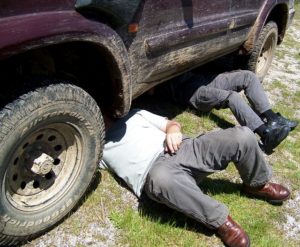One night over dinner, Andy told Shaun he thought it was time that Shaun practiced driving the family car—after Shaun met a few conditions. The pastor had agreed to give Andy a nonworking 1942 Oldsmobile, and if Shaun could make it run, it would be his, free and clear. I watched as the father and son re-created that discussion.
Shaun said, “I was thrilled to have a car we could work on, and I asked Dad, ‘Do I have to wait until the car is fixed to drive?’”
Andy said, “I said, ‘No. If you work on the car with me every day and we make good progress on the project, in a couple of months, I’ll take you out to Old Creek Road, hand you the keys to my car, and sit right next to you as you practice driving. Then you’ll be ready to drive the Oldsmobile once you get your license.’”
Shaun kept his part of the deal. Every day after school, he worked in the heated garage handing tools to his dad. At first his prosthetic hand frustrated him, as he’d fumble and drop tools into the engine area. Andy made him bend in to fish them out, but as Shaun did so, Andy would teach him about an engine part. Shaun caught on and rarely complained. If he had trouble, he worked to figure it out on his own, or he asked Andy for help.
I could see that these two were good at collaboration. It was fun to listen to Shaun talk about finally being able to sit next to Andy and drive the family car—at the age of fourteen.
Shaun also discovered that he was as excited to work on the 1942 Oldsmobile as he was driving his dad’s car for the first time. He said it dawned on him that even if the classic cruiser convertible wasn’t functioning to its full potential, it held the promise of beauty, style, and performance. In his mind, Shaun could picture an already finished car with a clean, black, shiny engine and a cream-colored body with red detailing sitting on big black tires around sixteen-inch chrome pancake hubs.
Andy was overjoyed to see his son’s dedication. It took father and son two years to get the Oldsmobile running. Often they waited for weeks after ordering hard-to-get parts, and they took breaks for holidays and for Shaun’s exams. But they both remained loyal to the project.
In the process of restoring the car, Shaun began treating all those around him with greater equity and fairness—showing no sign of being distracted, embarrassed, or limited by his disability. Although he didn’t always respect conventional rules, he followed mechanical guidelines faithfully. When he turned sixteen, his reward was owning the best-looking, sharpest automobile in town—the Olds 98.
Read the rest to the success story in the book, The Quiet Rich: Ordinary People Reawakening an American Dream.
Kevin J. Palmer, Author

